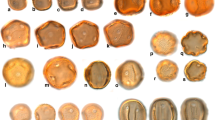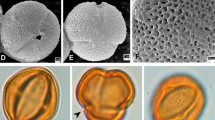Abstract
Pollen morphology of 36 species representing 14 genera within the tribe Rhinantheae in the family Orobanchaceae was studied and illustrated with light microscopy (LM) and scanning electron microscopy (SEM). Five major pollen types were recognized on the basis of exine ornamentation. Within these major types, minor types (subtypes) were distinguished based on exine surface pattern, size, shape, amb form, colpi and colpus membrane. These types and subtypes are as follows: type I. retipilate: subtype Ia. regular retipilate: (1) pollen size < 27 µm, (2) pollen size > 27 µm, subtype Ib. irregular retipilate; type II. verrucate: subtype IIa. macro-verrucate, subtype IIb. verrucate, subtype IIc. sparse verrucate; type III. retirugulate; type IV. granulate; type V. micro-reticulate. A key to pollen morphology of genera studied within the Rhinantheae was made based on pollen morphology from our study and earlier work. Combining with other sources of information on the Rhinantheae, the systematic relationships of this tribe are discussed. Rhinantheae pollen displays considerable variation between genera and species, with taxonomically significant characters at genus and species level. Palynological characteristics provide evidence for interpreting the conflicting views concerning the “Pterygiella Complex”. The evolutionary trend in exine sculpture of Rhinantheae could be proposed, namely that retipilate sculpturing which is the most widespread type is more primitive than the other types (such as foveolate, granulate, regulate, reticulate, retirugulate and verrucate). The pollen data in present study and the view of Hong (1986), as well as the molecular data from Bennett and Mathews (2006) indicated that Asia and related regions were likely to the origin centre of the tribe Rhinantheae.
Similar content being viewed by others
References
Arekal GD (1963). Embryological studies in Canadian representatives of the tribe Rhinantheae, Scrophulariaceae. Canad J Bot 41: 267–303
Argue CL (1980). Pollen morphology in the genus Mimulus (Scrophulariaceae) and its taxonomic significance. Amer J Bot 67: 68–87
Argue CL (1981). The taxonomic implications of pollen morphology in some South American species of Mimulus (Scrophulariaceae). Amer J Bot 68: 200–205
Belkina KV (1972). New palynological data on taxonomy of Yakutian species of Pedicularis. Bot Zhurn (Moscow & Leningrad) 57: 822–825
Bennett JR and Mathews S (2006). Phylogeny of the parasitic plant family Orobanchaceae inferred from phytochrome A. Amer J Bot 93: 1039–1051
Bentham G and Hooker JD (1876). Scrophularineae. Genera Plantarum Reeve & Co., London, 913–987
Bolliger M and Molau U (1992). Nothobartsia, a new genus of Scrophulariaceae from southwest Europe. Pl Syst Evol 179: 59–71
Bolliger M and Wick L (1990). The pollen morphology of Odontites (Scrophulariaceae) and its taxonomic significance. Pl Syst Evol 173: 159–178
Chuang TI and Heckard LR (1986). Systematics and evolution of Cordylanthus (Scrophulariaceae: Pediculareae). Syst Bot Monogr 10: 1–105
Chuang TI (1993). A cladistic analysis of the subtribe Castillejinae (Scrophulariaceae – tribe Pediculareae). Bot Bull Acad Sin 34: 155–161
Erdtman G (1952) Pollen morphology and plant taxonomy Angiosperms Almqvist & Wiksell, Stockholm.
Erdtman G (1960). The acetolysis method, a revised description. Svensk Bot Tidskr 54: 561–564
Hartl D (1957). Die Stellung von Lindenbergia Lehmann im System der Scrophulariaceen. Beitr Biol Pflanzen 33: 265–278
Hong D-Y, Yang H-B, Jin C-L, Holmgren NH (1998) Scrophulariaceae In: Wu Z-Y, Raven PH (eds) Flora of China vol. 18. Science Press, Beijing, Missouri Botanical Garden Press, St Louis, pp 210
Hong D-Y (1979) Scrophulariaceae (1). In: Flora Reipublicae Popularis Sinicae vol 67 (2). Science Press, Beijing, pp 1– 431
Hong D-Y (1986). A new genus of Scrophulariaceae from Xizang, China. Acta Phytotax Sin 24: 139–142
Hong D-Y (2001). Xizangia bartschioides (Hand.-Mazz.) DY Hong, a new combination in Scrophulariaceae. Acta Phytotax Sin 39: 544–546
Ikuse M (1956). Pollen grains of Japan. Hirokawa Publishing Co., Tokyo
Inceoğlu Ő, Karamustafa F (1977) The pollen morphology of plants in Ankara region IV. Scrophulariaceae. Commun Fac Sci Univ Ankara (C2: Bot) 21: 131–144.
Inceoğlu Ő (1982). Pollen grains in some Turkish Rhinantheae (Scrophulariaceae). Grana 21: 83–96
Juan R, Pastor J and Fernandez I (2000). SEM and light microscope observations on fruit and seeds in Scrophulariaceae from southwest Spain and their systematic significance. Ann Bot 86: 323–338
Li X-W (2002). Notes on some botanical names from China. Acta Bot Yunnan 24: 14–16
Minkin JP and Eshbaugh WH (1989). Pollen morphology of the Orobanchaceae and rhinanthoid Scrophulariaceae. Grana 28: 1–18
Natarajan AT (1957). Studies in the morphology of pollen grains – Tubiflorae. Phyton 8: 21–42
Olmstead RG, de Pamphilis CW, Wolfe AD, Young ND, Elisons WJ and Reeves PA (2001). Disintegration of the Scrophulariaceae. Amer J Bot 88(2): 348–361
Olmstead RG and Reeves PA (1995). Evidence for the polyphyly of the Scrophulariaceae based on chloroplast rbcL and ndhF sequences. Ann Missouri Bot Gard 82: 176–193
Olmstead RG (2005) Lamiales – Synoptical classification (Version 2.0 in progress), a web-accessible version. http://depts.washington.edu/phylo/classifications/Lamiales.vers.2.pdf.
Pennell FW (1935) The Scrophulariaceae of eastern temperate North America. Academy of Natural Sciences of Philadelphia, monograph no. 1. Wickersham, Lancaster, Penn
Punt W, Blackmore S, Nilsson S, Le Thomas AE (1994) Glossary of pollen and spore terminology. LPP Contributions Series No. 1. Utrecht, LPP Foundation, Laboratory of Palaeobotany and Palynology, University of Utrecht
Risch C (1939). Die Pollenkörner der in Deutschland wild wachsenden Scrophulariaceen. Ber Dtsch Bot Ges 57: 108–121
Tao D-D (1993). Phtheirospermum glandulosum — a new recorded species of Scrophulariaceae from Yunnan, China. Acta Bot Yunnan 15: 232
Tao D-D (1996). A taxonomic study on the genus Phtheirospermum (Scrophulariaceae) in China. Acta Bot Yunnan 18: 301–307
Tao D-D (1999). The identity of the genus Xizangia Hong (Scrophulariaceae). Acta Phytotax Sin 37(3): 281
Tsoong P-C, Chang K-T (1965) Palynological study of Pedicularis and its relation with the taxonomic systems of the genus. Acta Phytotax Sin 10: 257–281; 357–374
Tsoong P-C (1963) Scrophulariaceae (Pars II). In: Flora Reipublicae Popularis Sinicae. vol 68. Science Press, Bejing, pp 383
Varghese TM (1968). Studies in the family Scrophulariaceae – II Pollen morphology. J Palynology IV: 91–97
Wang H, Mill RR and Blackmore S (2003). Pollen morphology and infra-generic evolutionary relationships in some Chinese species of Pedicularis (Scrophulariaceae). Pl Syst Evol 237: 1–17
Wolfe AD, Pandle CP, Liu L and Steiner KE (2005). Phylogeny and biogeography of Orobanchaceae. Folia Geobot 40: 115–134
Wu Z-Y (1999) Two new combinations in Chinese Scrophulariaceae. Novon 9: 288
Young ND, Steiner KE and de Pamphilis CW (1999). The evolution of parasitism in Scrophulariaceae/Orobanchaceae: plastid gene sequences refute an evolutionary transition series. Ann Missouri Bot Gard 86: 876–893
Author information
Authors and Affiliations
Corresponding author
Rights and permissions
About this article
Cite this article
Lu, L., Wang, H., Blackmore, S. et al. Pollen morphology of the tribe Rhinantheae (Orobanchaceae) and its systematic significances. Plant Syst. Evol. 268, 177–198 (2007). https://doi.org/10.1007/s00606-007-0562-x
Received:
Accepted:
Published:
Issue Date:
DOI: https://doi.org/10.1007/s00606-007-0562-x




